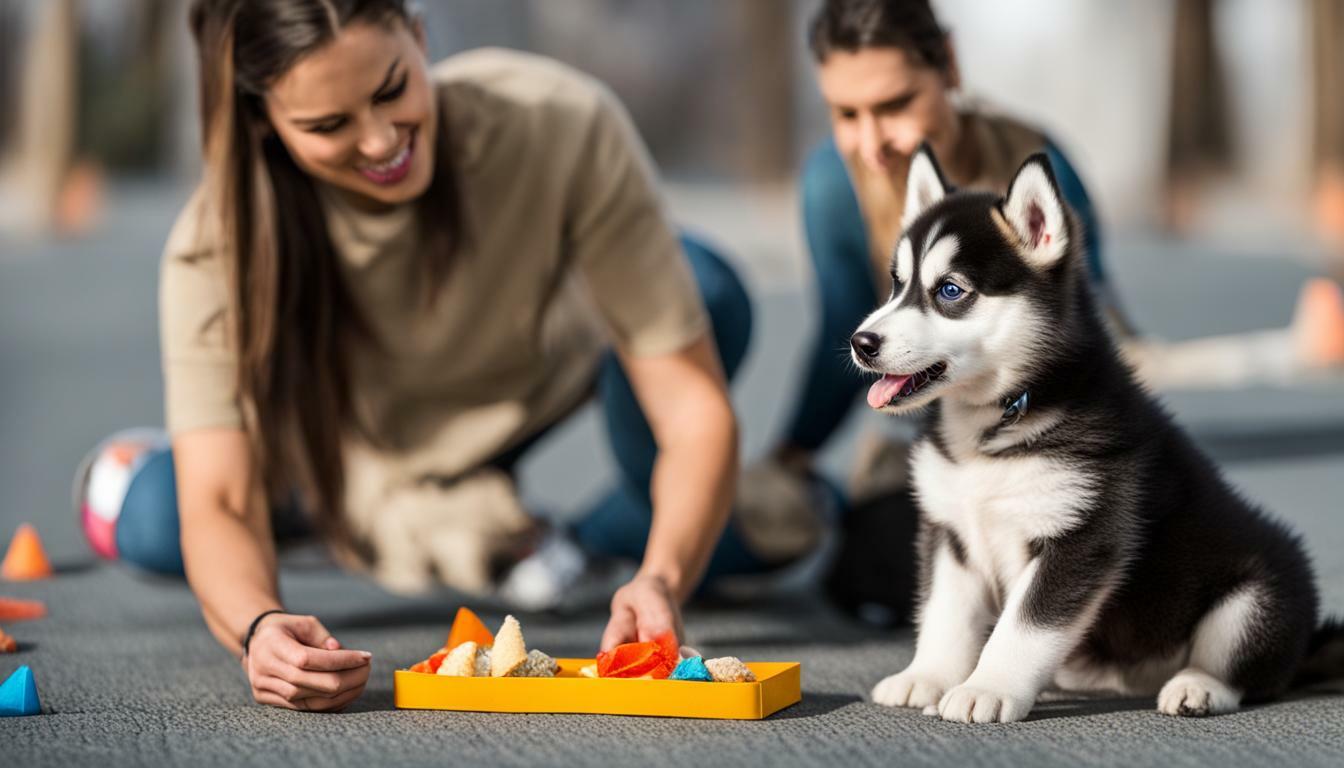Welcome to the ultimate guide on mastering Siberian Husky puppy training. In this article, we will provide you with valuable tips and techniques to ensure your Siberian Husky puppy grows up to be well-behaved and obedient. From working with a responsible breeder to establishing a consistent schedule, we will cover all aspects of training and raising a happy and healthy Siberian Husky.
Key Takeaways:
- Choose a responsible breeder who prioritizes socialization for a well-adjusted puppy.
- Crate training and establishing a schedule are vital for potty training and discipline.
- Obedience training and mental/physical stimulation are crucial for a well-behaved Husky.
- Consider sport training and various classes for continued development.
- Prevent escape and set appropriate boundaries to ensure your Husky’s safety.
By following the techniques and tips outlined in this article, you will be on your way to mastering Siberian Husky puppy training. Remember, consistency, patience, and positive reinforcement are key to shaping your Husky into a well-rounded companion.
Working with a Responsible Breeder and Socializing Your Puppy
To lay the foundation for successful training, it’s crucial to work with a reputable breeder and ensure your Siberian Husky puppy receives proper socialization. A responsible breeder will prioritize the health and temperament of their puppies, which greatly influences their ability to learn and thrive. When choosing a breeder, look for someone who is knowledgeable, transparent, and genuinely cares about the well-being of their dogs.
Socializing your Siberian Husky puppy from a young age is vital for their development and behavior. Exposing them to various people, animals, and environments helps them become well-rounded and adaptable. Arrange playdates with other friendly dogs, introduce them to different sights and sounds, and take them on outings to parks or pet-friendly establishments. Gradually increase the level of exposure to help them build confidence and prevent fear or aggression issues.
Remember, socialization is an ongoing process, so continue exposing your puppy to new experiences even as they grow older. Proper socialization sets the stage for your puppy to become a happy, well-adjusted adult, and greatly contributes to their overall training success.
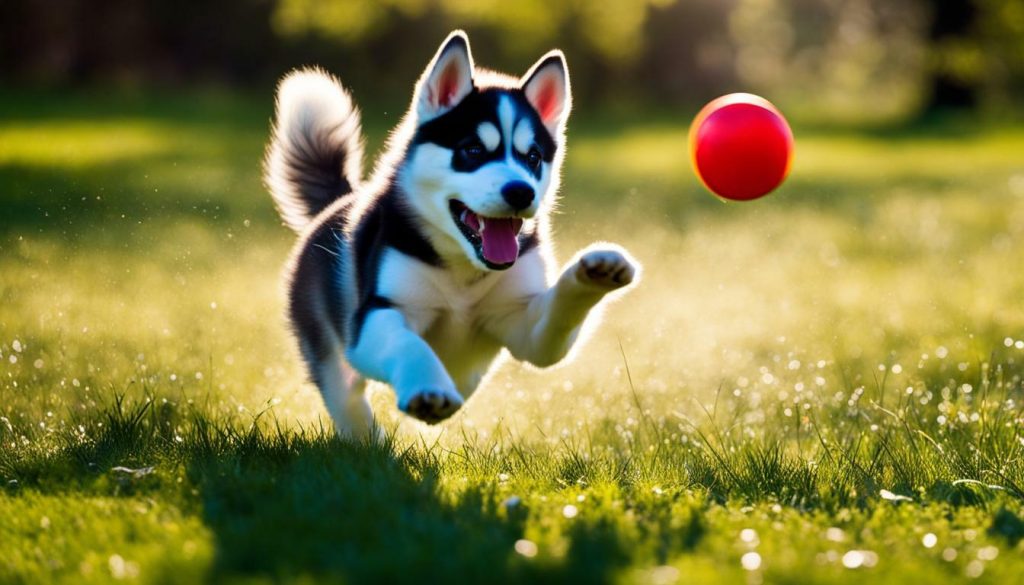
| Benefits of Working with a Responsible Breeder and Socializing Your Puppy: |
|---|
| • Ensures a healthy and well-tempered puppy. |
| • Sets the foundation for successful training. |
| • Prevents behavior problems like fear and aggression. |
| • Enables your puppy to adapt to new environments and situations. |
Crate Training and Establishing a Schedule
Crate training and establishing a schedule are key components in ensuring your Siberian Husky puppy’s comfort and well-being. Crates provide a safe and cozy space for your puppy to retreat to when they need some downtime or when you need to leave them alone for short periods.
When introducing crate training, it’s important to make it a positive experience for your puppy. Start by placing treats and toys inside the crate to entice them to explore. Gradually increase the time your puppy spends in the crate, rewarding them with praise and treats for good behavior. Remember to never use the crate as a form of punishment.
Establishing a schedule is equally essential in training your Siberian Husky puppy. Dogs thrive on routine, and having a consistent schedule helps them understand what is expected of them. Set regular mealtimes, potty breaks, walks, and training sessions. This will help your puppy learn important skills such as potty training and obedience commands.
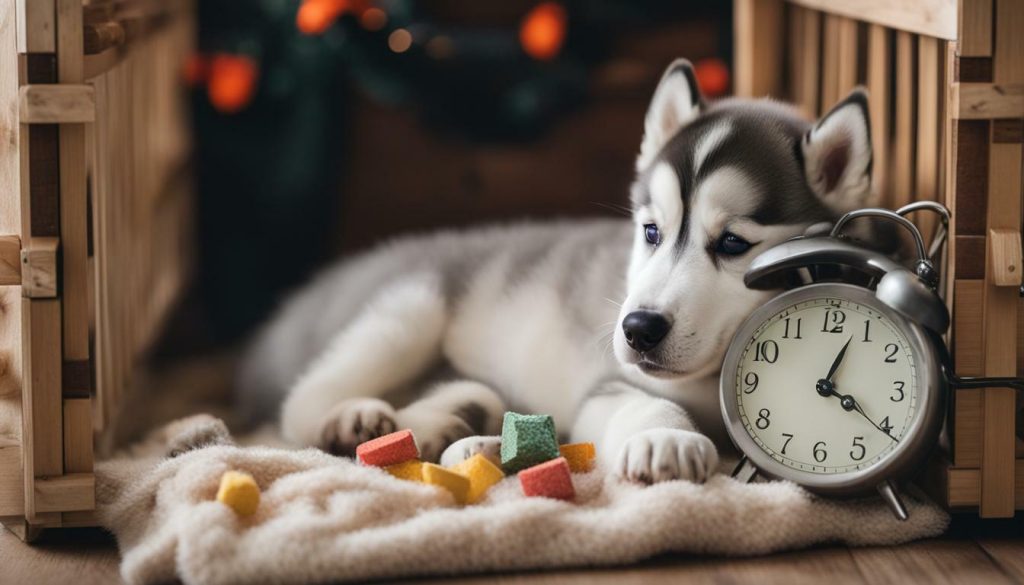
| Time | Activity |
|---|---|
| 7:00 AM | Take puppy out for a potty break |
| 7:30 AM | Feed puppy |
| 8:00 AM | Playtime and socialization |
| 9:00 AM | Training session |
| 12:00 PM | Take puppy out for a potty break |
| 12:30 PM | Lunchtime |
| 1:00 PM | Quiet time in crate |
| 4:00 PM | Playtime at the park |
| 6:00 PM | Dinner |
| 7:00 PM | Evening walk |
| 8:00 PM | Training session |
| 9:00 PM | Bedtime in the crate |
Important Tips:
- Ensure the crate is the appropriate size for your puppy, allowing them to stand up, turn around, and lie down comfortably.
- Use a consistent command, such as “crate” or “kennel,” when asking your puppy to enter the crate.
- Gradually increase the duration of crate time, starting with short intervals and gradually working up to longer periods.
- Avoid leaving your puppy in the crate for extended periods, as they need regular exercise and socialization.
Crate training provides your Siberian Husky puppy with a secure space of their own, while establishing a schedule ensures they know what to expect throughout the day. Remember to be patient, consistent, and reward good behavior, and your puppy will quickly adapt to their crate and thrive with the structure of a schedule.
Obedience Training and Keeping Your Husky Active
Obedience training and an active lifestyle are essential for raising a well-behaved and happy Siberian Husky puppy. These intelligent and energetic dogs thrive on mental and physical stimulation, making obedience training a crucial part of their development.
To begin with, focus on teaching basic commands such as sit, stay, and come. Start training sessions in a quiet and distraction-free environment, using positive reinforcement techniques like treats or praise to reward your puppy for correct responses. Consistency and patience are key when working with a Husky puppy, as they can be independent and stubborn at times.
Additionally, it’s vital to keep your Husky active to prevent boredom and destructive behavior. Regular exercise is essential to meet their energy needs. Engage in activities like daily walks, jogging, or interactive play sessions. Huskies also excel in dog sports such as agility, obedience trials, or even sledding if you live in a suitable climate.
| Benefits of Obedience Training and an Active Lifestyle for Your Husky Puppy |
|---|
| 1. Improved behavior and socialization skills |
| 2. Strengthened bond between you and your puppy |
| 3. Mental stimulation and reduced boredom |
| 4. Physical exercise for maintaining a healthy weight |
| 5. Enhanced overall happiness and well-being |
Remember to tailor the training and exercise routines to suit your puppy’s age and abilities. It’s important not to overexert them, especially during their growth stages. Consulting with a professional dog trainer or joining obedience classes can provide valuable guidance and support in ensuring effective training techniques and a well-rounded approach to keeping your Husky active.
By dedicating time and effort to obedience training and providing ample opportunities for exercise and mental stimulation, you’ll be setting your Siberian Husky puppy on the path to becoming a well-behaved and content companion.
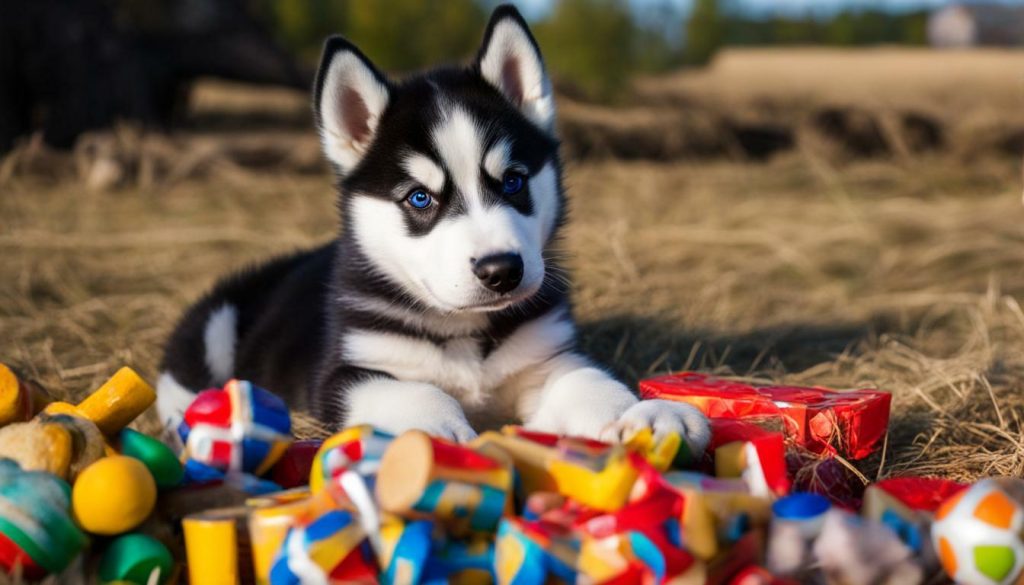
“Training my Husky puppy has been an incredible journey. Through obedience training, I’ve not only taught him vital commands but also strengthened our bond. Keeping him active with regular walks and playtime has made him a happy and well-behaved pet.”
– Sarah, proud Husky owner
“My Siberian Husky puppy’s obedience training has been a game-changer. He’s become more responsive and attentive, making our daily routines so much smoother. We love going on adventures together, and his agile nature shines in agility classes!”
– Mark, enthusiastic Husky parent
Sport Training and Classes for Continued Development
Take your Siberian Husky puppy’s training to the next level by introducing sport training and enrolling them in a variety of classes. Sport training not only enhances their physical abilities but also stimulates their intelligent minds. By participating in activities such as agility, obedience trials, and flyball, your Husky will develop discipline, focus, and confidence. These sports provide mental and physical stimulation, which is essential for the development of a well-rounded and happy dog.
One popular sport for Siberian Huskies is agility, where the dog navigates through an obstacle course. It helps improve their coordination, speed, and problem-solving skills. Additionally, obedience trials teach them to follow commands and perform specific tasks with precision. These trials are perfect for reinforcing basic obedience training and strengthening the bond between you and your pup.
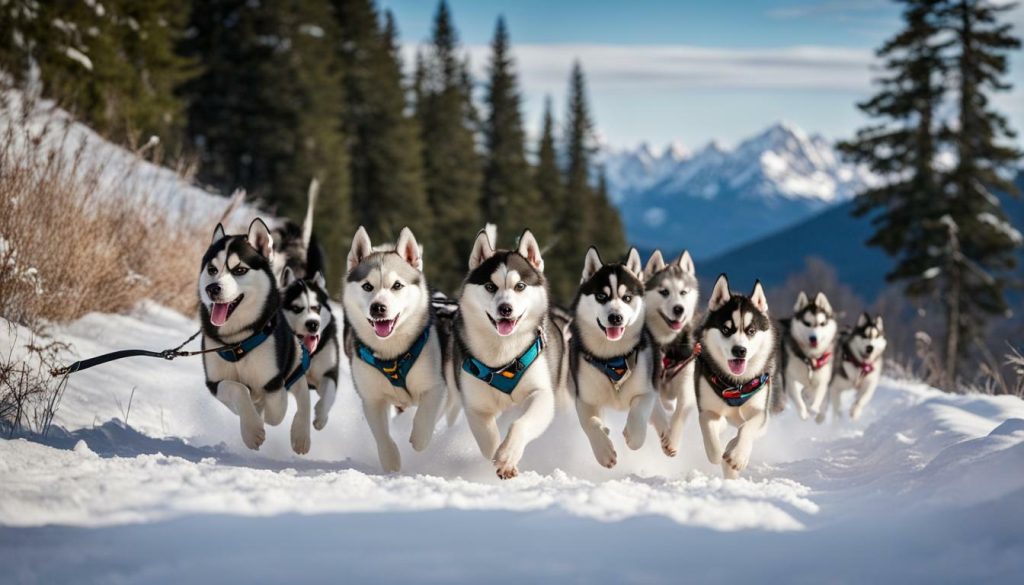
Participating in sports and enrolling in classes not only provides physical exercise but also challenges your Husky’s mental capabilities. It is an excellent way to channel their energy, prevent behavioral issues, and keep them engaged and stimulated.
When choosing classes for your Husky, consider their age, temperament, and individual interests. Puppy socialization classes are a great starting point, allowing them to interact with other dogs and people in a controlled environment. Beginners’ obedience classes can establish a strong foundation for further training, while advanced obedience classes will challenge their skills and improve their responsiveness to commands.
Recommended Classes for Siberian Huskies:
- Agility training
- Obedience trials
- Disc dog (frisbee) training
- Nose work classes
- Canine freestyle (dog dancing)
These classes not only promote physical fitness but also provide mental stimulation. Remember, consistent training and positive reinforcement are key to successfully mastering any sport or activity with your Siberian Husky puppy. Enjoy the journey together and watch as their skills and abilities flourish.
| Benefits of Sport Training for Siberian Husky Puppies: |
|---|
| Improves coordination and problem-solving skills |
| Enhances focus, discipline, and confidence |
| Provides mental and physical stimulation |
| Strengthens the bond between owner and puppy |
Preventing Escape and Setting Appropriate Boundaries
Safeguard your Siberian Husky puppy’s environment by implementing strategies to prevent escape and setting boundaries. These active and curious dogs have a strong instinct to explore, making it essential to establish a secure environment that ensures their safety. Here are some effective techniques to help you create a secure space for your furry friend:
- Fence it in: Install a sturdy fence around your yard, ensuring that it is tall enough to prevent jumping or climbing over. Regularly inspect the fence for any gaps or weak points that need reinforcement.
- Use secure gates: Install gates that are self-locking and high enough to prevent your Husky from opening them. Consider adding a latch or lock for extra security.
- Supervise outdoor time: When your Husky is outside, always keep a watchful eye on them. Avoid leaving them unattended, as they may attempt to dig, jump, or squeeze through small openings.
- Create a designated play area: Dedicate a specific area within your yard where your Husky can play and roam freely. This will help them understand their boundaries and minimize the chances of escape.
Additionally, it’s essential to provide your Siberian Husky puppy with plenty of mental and physical stimulation to prevent boredom and reduce the likelihood of escape attempts. Regular exercise, interactive toys, and puzzle games can keep them engaged and content. Remember, a tired and happy Husky is less likely to feel the need to explore beyond their boundaries.
“A tired and happy Husky is less likely to feel the need to explore beyond their boundaries.”
Remember, setting boundaries is not limited to the physical environment. It’s also crucial to establish rules and guidelines within your home. Consistency is key when teaching your Husky what is acceptable behavior and what is not. Encourage positive behaviors through rewards and praise, while gently correcting any undesirable actions.
Example of a Boundary Setting Schedule:
| Time | Activity |
|---|---|
| 7:00 AM | Morning walk on a leash |
| 8:00 AM | Breakfast in designated eating area |
| 12:00 PM | Playtime in the designated play area |
| 2:00 PM | Training session for obedience and commands |
| 4:00 PM | Interactive puzzle toy time |
| 6:00 PM | Evening walk on a leash |
| 7:00 PM | Dinner in designated eating area |
| 8:00 PM | Quiet time and relaxation indoors |
By implementing these strategies and being consistent in your training, you can ensure a safe and enjoyable environment for your Siberian Husky puppy. Remember, preventing escape and setting boundaries is essential for their well-being and gives you peace of mind.
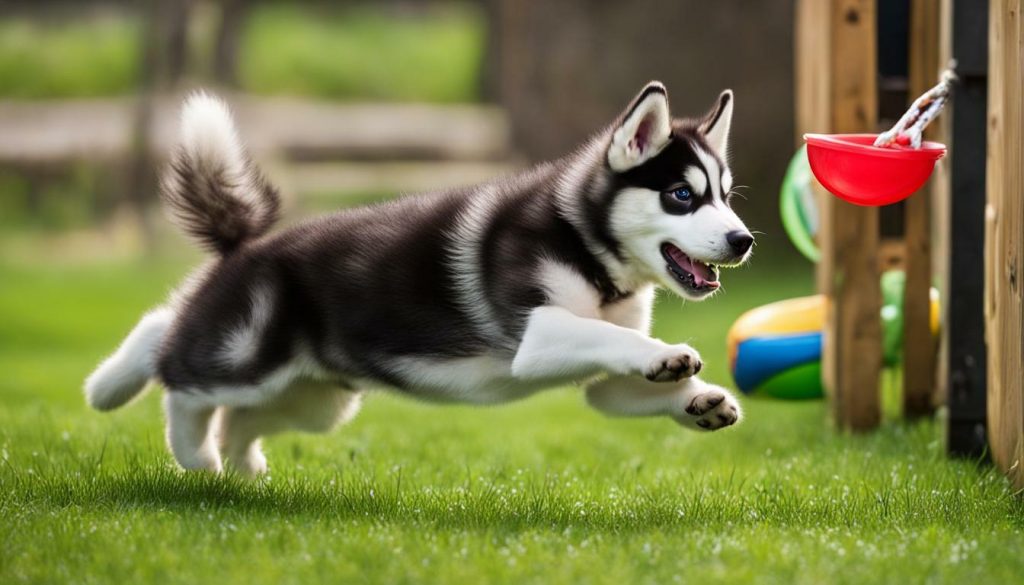
Learn how to provide your Siberian Husky puppy with the appropriate nutrition, grooming, and eye care for their overall well-being. Proper feeding and grooming practices are essential to keep your puppy healthy, while regular eye care can prevent potential issues. Here are some important tips to consider:
- Nutrition: Ensure your Siberian Husky puppy receives a balanced diet that meets their nutritional needs. Consult with your veterinarian to determine the best food option, whether it’s commercial kibble or a raw diet. Remember to follow feeding guidelines based on your puppy’s age, weight, and activity level.
- Grooming: Regular grooming sessions will help keep your puppy’s coat clean and free from tangles. Brush their fur at least once a week to remove loose hair and prevent matting. Additionally, schedule regular baths using dog-friendly shampoo. Don’t forget to trim their nails regularly to avoid discomfort and potential injuries.
- Eye Care: Your Siberian Husky puppy’s eyes are sensitive and require proper care. Clean them gently with a damp cloth to remove any dirt or discharge. Watch out for signs of irritation, excessive tearing, or redness, as these may indicate an underlying issue. If you notice any problems, consult your veterinarian immediately.
To visualize the importance of eye care, take a look at this adorable Siberian Husky puppy:
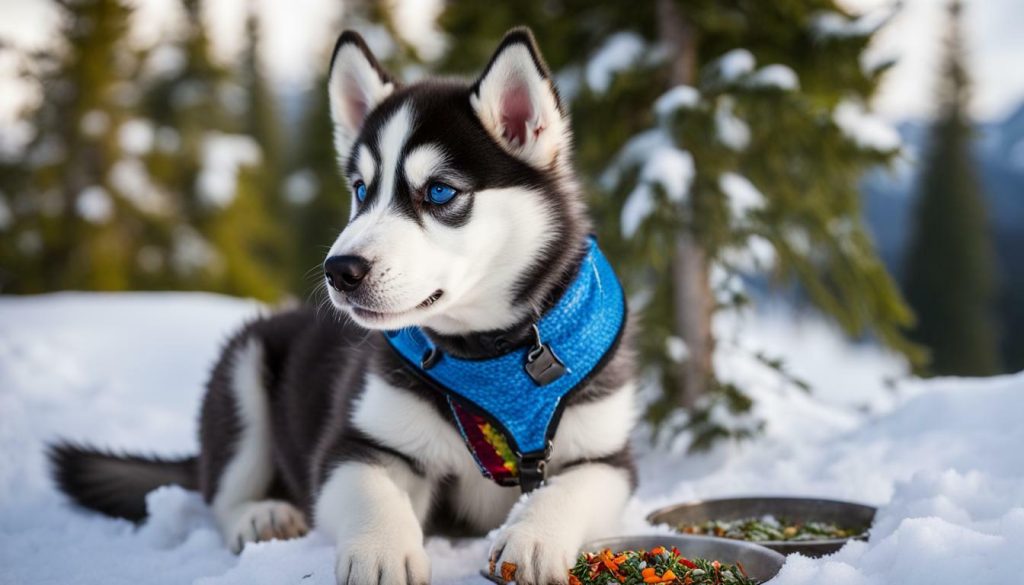
Remember, maintaining a consistent feeding and grooming routine, along with regular eye care, can contribute to your Siberian Husky puppy’s overall health and well-being. By providing them with the necessary nutrition, grooming, and eye care, you are setting the foundation for a happy and healthy companion.
Key Takeaways:
- Feed your Siberian Husky puppy a balanced diet recommended by your veterinarian.
- Groom their coat regularly to keep it clean and free from tangles.
- Take care of their eyes by cleaning them gently and monitoring for any signs of irritation or redness.
Following these tips will help ensure that your Siberian Husky puppy grows into a healthy and happy adult dog.
| Feeding | Grooming | Eye Health |
|---|---|---|
| Consult a veterinarian for a balanced diet | Brush their coat regularly | Clean their eyes with a damp cloth |
| Follow feeding guidelines based on age, weight, and activity level | Use dog-friendly shampoo for baths | Watch out for signs of irritation or excessive tearing |
| Ensure fresh water is always available | Trim their nails regularly | Consult a veterinarian if any issues arise |
Potty Training and Housebreaking
Discover the best practices for potty training and housebreaking your Siberian Husky puppy to maintain a clean and hygienic living space. Potty training is an essential aspect of raising a well-behaved and disciplined puppy. With proper training and consistency, you can teach your Siberian Husky to relieve themselves in designated areas.
Start by establishing a routine for your puppy. Take them outside to their designated potty area at regular intervals throughout the day, such as after meals, playtime, and waking up from naps. This consistency will help them understand where and when to go potty. Use positive reinforcement, such as treats and praise, when they successfully use the designated area.
In addition to scheduled potty breaks, closely monitor your puppy’s behavior for signs that they need to go. These signs may include sniffing the ground, circling, or suddenly becoming restless. If you notice any of these signs, immediately take them outside to their designated area to avoid accidents indoors.
| Tip | Description |
|---|---|
| Consistency is Key | Stick to a regular potty schedule to establish a routine and reinforce good habits. |
| Positive Reinforcement | Reward your Siberian Husky puppy with treats and praise when they successfully use the designated potty area. |
| Supervision | Keep a close eye on your puppy’s behavior and immediately take them outside if you notice signs that they need to go. |
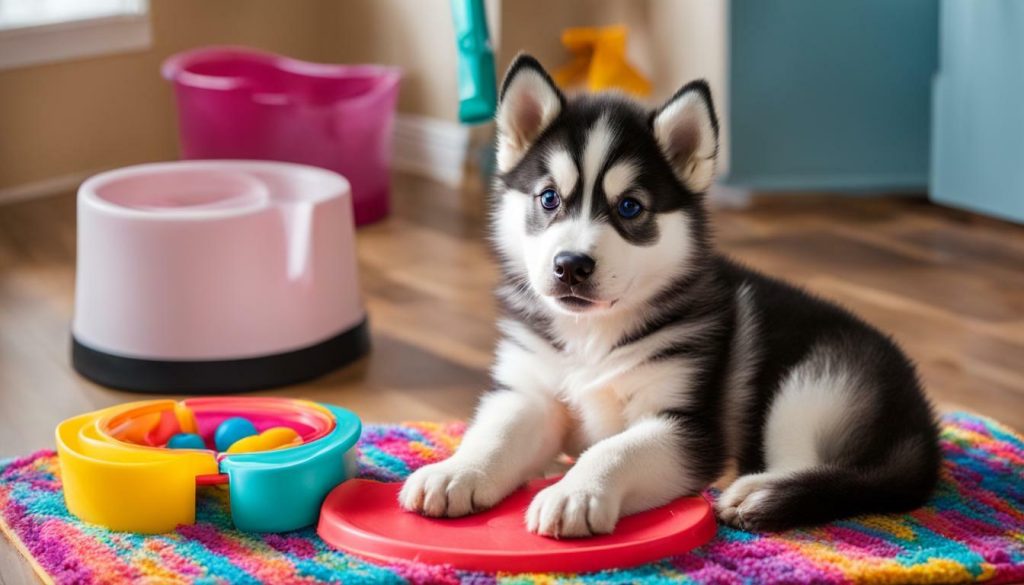
Remember, accidents happen, especially during the early stages of potty training. If your puppy has an accident indoors, do not scold or punish them. Instead, clean up the mess thoroughly and continue with consistent training. Punishment can create fear and anxiety, hindering the training progress. Patience and positive reinforcement are key in successful potty training.
Housebreaking is another crucial aspect of training your Siberian Husky puppy. It involves teaching them to respect your home and not engage in destructive behavior. To prevent accidents or unwanted chewing, ensure your puppy has a designated space where they can rest and play comfortably, such as a crate or a designated puppy-proofed area.
Housebreaking Tips:
- Set clear boundaries and use baby gates or closed doors to restrict access to certain areas of your home.
- Provide appropriate toys and chew items to satisfy their natural urge to chew.
- Supervise your puppy when they are roaming freely in the house and redirect their attention if they show signs of chewing on furniture or other inappropriate items.
By following these potty training and housebreaking tips, you can create a harmonious living environment for both you and your Siberian Husky puppy. Remember, patience and consistency are key to successful training. With time and effort, your puppy will learn and grow into a well-behaved and housebroken companion.
Crate Training, Leash Training, and Clicker Techniques
Maximize your Siberian Husky puppy’s training potential with effective crate training, leash training, and the use of clicker techniques. These three methods are essential for establishing boundaries, teaching obedience, and fostering a strong bond with your furry companion.
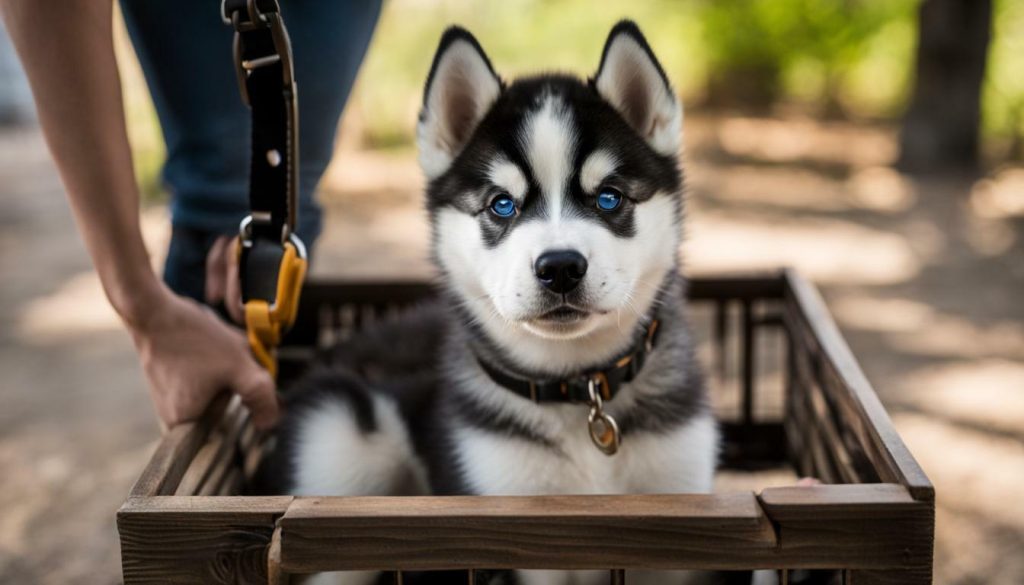
Crate training is an invaluable tool for housebreaking your puppy and providing them with a safe and secure space of their own. Start by introducing your puppy to the crate gradually, using positive reinforcement and treats to create a positive association. Make the crate a comfortable and inviting space, with a soft bed and toys. Use the crate for short periods, gradually increasing the duration as your puppy becomes more comfortable. Remember to never use the crate as a form of punishment, as it should be a positive and nurturing environment for your pup.
Leash training is crucial for teaching your Siberian Husky puppy to walk on a leash without pulling or dragging. Start by introducing the leash in a calm and controlled environment, allowing your puppy to sniff and become familiar with it. Attach the leash to your puppy’s collar or harness and let them become accustomed to the sensation of being gently guided. Start with short walks, providing plenty of praise and treats for good behavior. Consistency is key when leash training, so be patient and persistent with your pup.
Clicker training is a highly effective method for teaching commands and reinforcing positive behavior. The clicker acts as a marker to signal to your puppy that they have performed the desired action correctly. Begin by associating the clicker with treats, clicking and immediately rewarding your puppy. Then, introduce the clicker during obedience training sessions, clicking when your puppy follows a command correctly and rewarding them with praise and treats. With consistent practice, your Siberian Husky puppy will quickly learn to associate the clicker with positive reinforcement and respond eagerly to your commands.
| Key Points | Benefits |
|---|---|
| Effective crate training | Facilitates housebreaking and provides a safe space |
| Leash training | Teaches walking etiquette and control on walks |
| Clicker techniques | Reinforces positive behavior and accelerates learning |
By incorporating crate training, leash training, and clicker techniques into your Siberian Husky puppy’s training routine, you can establish a solid foundation for their development and obedience. Remember to be patient, consistent, and always use positive reinforcement. With time and dedication, you will witness your puppy grow into a well-behaved and happy companion.
Conclusion
Congratulations on taking the first steps towards mastering Siberian Husky puppy training. Remember, with patience, consistency, and positive reinforcement, you can raise a well-behaved and happy Husky.
In this article, we have provided valuable information on training Siberian Husky puppies. We emphasized the importance of working with a responsible breeder and socializing your puppy from a young age. Proper crate training and establishing a schedule are crucial for their development. Additionally, getting your puppy used to grooming and nail trimming is essential for their overall well-being.
We highlighted the significance of obedience training and keeping your Husky active through play. Starting sport training at four months and continuing with various classes for up to a year can further enhance their skills and abilities.
Setting appropriate boundaries and preventing escape are crucial aspects of their training. Giving them plenty of exercise and introducing them to other people and animals will help them become well-adjusted and sociable companions.
Feeding, grooming, and maintaining eye health are important aspects of caring for your Siberian Husky. Finally, we provided effective methods and techniques for successful potty training and housebreaking.
Remember, training your Siberian Husky puppy is a journey that requires time, effort, and patience. Stick to the techniques and methods mentioned in this article, and you will be well on your way to having a well-trained and obedient companion.
FAQ
What should I look for in a responsible breeder?
When looking for a responsible breeder, check for proper health testing, clear communication, and a clean and safe environment for the puppies. Ask about the breeder’s experience and knowledge of the Siberian Husky breed.
How important is socializing my Siberian Husky puppy?
Socializing your Siberian Husky puppy from a young age is crucial for their development and well-being. It helps them become comfortable around people, other animals, and new environments, reducing the chances of behavior issues in the future.
Is crate training necessary for my Husky puppy?
Yes, crate training is highly recommended for Siberian Husky puppies. It provides them with a safe and comfortable space, helps with potty training, and prevents destructive behaviors when unsupervised.
How can I establish a schedule for my Husky puppy?
To establish a schedule for your Husky puppy, set consistent times for meals, potty breaks, training sessions, playtime, and rest. This routine will help them feel secure and understand what is expected of them.
What is the importance of obedience training for my Husky?
Obedience training is essential for a well-behaved Husky. It teaches them basic commands and helps establish you as the pack leader. Proper obedience training ensures their safety and the harmony of your household.
How can I keep my Husky active and engaged?
Keeping your Husky mentally and physically active is crucial. Engage them in regular exercise, such as daily walks or runs, and provide stimulating toys and activities. Mental stimulation through puzzles and training sessions is also important.
When can I start sport training with my Husky puppy?
Sport training can start around four months of age. It is advisable to consult with a professional trainer to ensure proper technique and safety. Various classes and sports, such as agility and obedience, can be continued for up to a year.
How can I prevent my Husky from escaping?
Preventing escape requires secure fencing, supervision while outdoors, and regular exercise to minimize energy levels. Training your Husky to respond to recall commands and providing mental stimulation also helps divert their focus from escaping.
What should I know about feeding, grooming, and eye health for my Husky?
Proper feeding, regular grooming, and maintaining eye health are essential for your Husky’s well-being. Feed them a high-quality diet, establish a grooming routine, and monitor their eyes for any signs of infection or abnormalities.
How can I successfully potty train and housebreak my Husky puppy?
Successful potty training and housebreaking require consistency, positive reinforcement, and patience. Take your Husky puppy outside frequently, reward them for eliminating in the right spot, and establish a regular potty routine.
What are some effective techniques for crate training, leash training, and clicker training?
Crate training requires introducing the crate gradually, associating it with positive experiences, and using rewards. Leash training involves teaching your Husky to walk calmly on a leash using positive reinforcement. Clicker training uses a clicker sound to mark desired behaviors and reward them accordingly.
